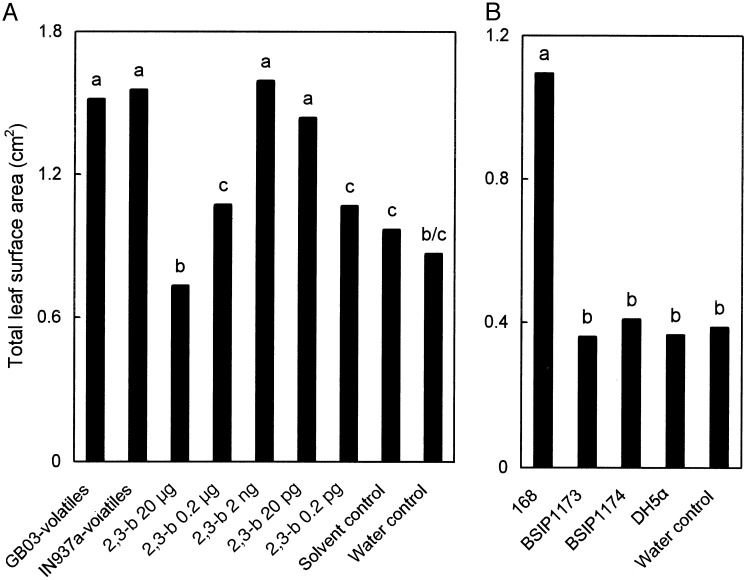PLANT BIOLOGY. For the article “Bacterial volatiles promote growth in Arabidopsis,” by Choong-Min Ryu, Mohamed A. Farag, Chia-Hui Hu, Munagala S. Reddy, Han-Xun Wei, Paul W. Paré, and Joseph W. Kloepper, which appeared in issue 8, April 15, 2003, of Proc. Natl. Acad. Sci. USA (100, 4927–4932; First Published April 8, 2003; 10.1073/pnas.0730845100), the authors note the following. Due to a printer's error on page 4930, bars 3 through 7 of histogram A of Fig. 4 were incorrectly labeled. The corrected figure and a corrected legend appear below.
Fig. 4.
Growth promotion of A. thaliana ecotype Col-0 with exposure to extracted bacterial volatiles from growth-promoting (GB03 and IN937a) and nongrowth-promoting (DH5α) bacteria and synthetic 2,3-butanediol (A) and exposure to volatiles released from B. subtilis WT (168) and mutant strains defective in the production of 2,3-butanediol (BSIP1173 and BSIP1174) (B). Different letters indicate significant differences between treatments according to least significant difference at P = 0.05. A dose–response curve with synthetic 2,3-butandiol in the presence of A. thaliana seedlings confirmed the efficacy of this volatile bacterial metabolite in promoting plant growth. The level of exogenous 2,3-butanediol (2 ng) that was observed to trigger optimal plant growth promotion was lower than those collected from the GB03 or IN937a strains over the 24-h collection interval (1–5 μg), and it may be at least in part due to a high initial release of the synthetic 2,3-butanediol when introduced into the I-plates containing the Arabidopsis seedlings, as compared to the more even emissions of VOCs generated from the bacterial strains.



